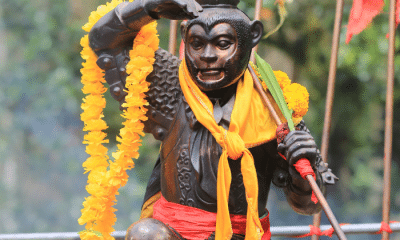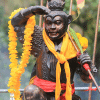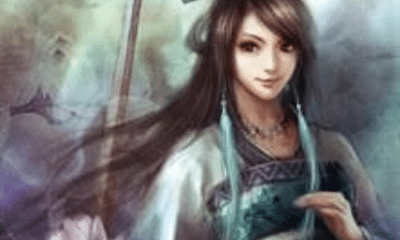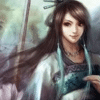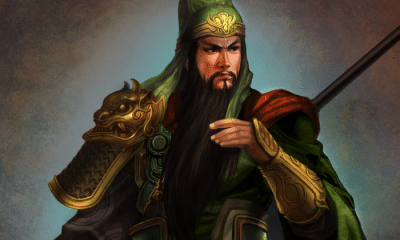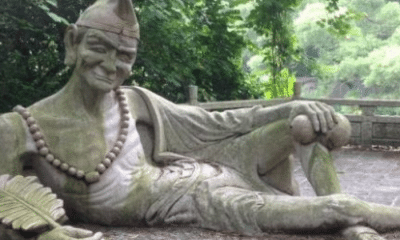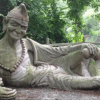Chinese
Yama: The King of Hell
The judge of the dead was not exclusive to any single culture in Asia. Keep reading to learn how Yama became a well-known figure across nearly an entire continent!
The figure of Yama clearly shows how ideas spread throughout the cultures of Asia.
He originated as a death-bringing god of Vedic Hinduism. Buddhist thought introduced him as a protector of the law and a judge of those who did wrong.
As Buddhism spread throughout Asia, each culture imagined its own unique take on the character. The concept of a judge remained, but his name, imagery, and the crimes he pursued changed.
Of course, many East Asian cultures took Yama from China rather than directly from Indian tradition. Yanluo Wang, the local version of the king of the underworld, was already a character that showed uniquely Chinese characteristics.
Yama in Buddhist Cultures
As a deity, Yama may be one of the most widespread figures in all of world mythology.
Yama, or Yamaraja, originated as a deity in Vedic Hinduism. He is a fearsome god who carries a noose to catch the souls of men who are about to die.
When Buddhism developed in India, many of the beliefs of Hinduism were incorporated into the new religion. The philosophical teachings of the Buddha were applied to the existing belief in gods, demons, and reincarnation.
Buddhism place significantly more emphasis on a person’s behavior and actions, however. In the emerging beliefs of Indian Buddhists, Yama became a judge as well as a hunter of the dead.
This did not mean, however, that he was an evil being. Gods such as Yama were called dharmapalas, or “defenders of the law.”
The Buddhist Yama was the ruler of the Narakas, or “Hell Realms.” When a person died, their soul was judged by Yama and, if found to be unworthy, it was sent to the Narakas.
This punishment was reserved for those who acted without regard for the karmic consequences of their actions. Those who committed offenses against the elderly, infirm, ascetics, or children were most likely to be brought before Yama.
Punishment in the Narakas was brutal, but it was not eternal. In the Pali canon of Theravada Buddhism, the Buddha specified that punishment was only recommended for as long as it took the results of the person’s worldly actions to exhaust themselves. Once the effects of wickedness no longer impacted the world, the person would reenter the cycle of reincarnation and have the chance to live a better life.
As Buddhism spread throughout Asia, the figure of Yama was spread as well. Each culture had its own variation of the character, however.
In Tibetan Buddhism, Shinje is the supreme mover of the rebirth cycle. His name was changed, but its origins can be seen in that of his wife, Yami.
In Japan, he is called Enma after the older name Yenma. He is portrayed as a furious god who particularly punishes liars.
In Korea, he is known as Yeom-Ra. The Vietnamese recognize ten similar deities known as the Diêm La.
All these East Asian cultures derived their underworld god from both Buddhist texts and the Chinese Yanluo Wang. King Yan, as he is known shows that the archetype is not limited to Buddhist teachings.
My Modern Interpretation
In China, Yanluo Wang, sometimes known as Yamla or King Yan, oversees the ten demonic gods who rule in Diyu. In keeping with the teachings of Sanskrit texts, King Yan acts as a judge of the dead in addition to their ruler.
Yanluo, however, has several distinctly Chinese aspects.
He always appears in male form. In addition to the ten kings, he is also assisted by two spirits known as Bullhead and Horseface.
Yanluo Wang is the high judge of Diyu, the Chinese underworld, but he is not the only one who passes judgment on the dead. He is accompanied by a lesser judge who holds listing every soul and the appointed date of each person’s death.
Bullhead and Horseface bring every person who dies before these judges. Unlike many other iterations of Yama, Yanluo Wang personally oversees the fate of every person rather than just those who have already shown wickedness.
Men and women who lived good lives are rewarded with a favorable reincarnation or, in some cases, revival in their most recent life. Those who are lacking, however, are sentenced to punishment in Diyu.
Yanluo Wang was influenced by Buddhist teachings, but he was also a deity that preceded the introduction of Buddhist philosophy to China. The character was not a direct adoption of Yama, but a blending of both Chinese and Buddhist beliefs.
This mixing of traditions is a hallmark of Chinese religion. Syncretism means that the same deity can be revered in all of China’s faiths.
While Buddhists see Yanluo Wang as the same protector of dharma that’s described in Buddhist texts, Taoists see him as a judge of their own religion’s tenants. Others see him as an arbiter of whether a person lived by Confucian teachings, and modern Christians may even see him as a manifestation of the Biblical Satan.
Historically, Chinese people could also see a reflection of their own culture in the specific way Diyu was administered.
Looking at both their own traditions and Buddhist references, Chinese people often disagreed on how many distinct realms, and kings, there were in Diju. Some accounts claimed that as many as 136 individual hells existed in the underworld.
Additionally, the exact identity of Yanluo Wang was unclear. Some traditions claimed that he was not a specific deity, but that the role of the judge was filled by qualified gods or even men.
Imperial China was renowned for its bureaucracy. While the states of India or Japan may have had a single clear authority, the multiple judges and innumerable rulers of Diyu would have been familiar to people in many eras of Chinese history.
While the many religions of China have all adopted Yanluo Wang as their own, it’s likely that even his pre-Buddhist origins are not entirely Chinese.
While he adopted the bureaucracy and morals of China, King Yan was likely based on the older, Vedic version of Yama. His early incorporation into Chinese mythology shows that East Asian religions did not, in fact, develop entirely independently of those of Indo-European culture.
In Summary
The deity Yama originated in Vedic Hinduism in India. When adopted by Buddhists, he judged the dead based on the laws and ideals of the Buddha.
These teachings spread throughout Asia, and with them went the character of Yama. In each culture of the region he was given a name and identity that fit not only Buddhist teachings, but also local cultures and values.
In the Chinese version, Yanluo Wang, ruled over a multitude of kings in the underworld. As either a deity or an appointee to the position, he judged an underworld with a complex bureaucracy that mirrored China’s own.
Yanluo Wang was recognized by people of all of China’s traditional religions, not just Buddhism. He also likely predated the arrival of the Buddha’s teachings to the country, showing that the mixture and coexistence of religious ideas was part of Chinese culture from its earliest history.


